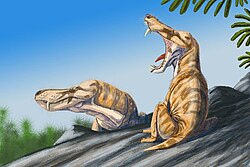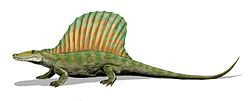| Sphenacodontia Temporal range: Late Pennsylvanian-Recent, | |
|---|---|
 | |
| 3D restoration of Dimetrodon grandis , a sphenacodontid | |
 | |
| Restoration of a pair of Alopecognathus angusticeps , a therocephalian therapsid | |
| Scientific classification | |
| Domain: | Eukaryota |
| Kingdom: | Animalia |
| Phylum: | Chordata |
| Clade: | Synapsida |
| Clade: | Sphenacomorpha |
| Clade: | Sphenacodontia Romer & Price, 1940 |
| Subgroups | |
Sphenacodontia is a stem-based clade of derived synapsids. It was defined by Amson and Laurin (2011) as "the largest clade that includes Haptodus baylei , Haptodus garnettensis and Sphenacodon ferox , but not Edaphosaurus pogonias ". [4] They first appear during the Late Pennsylvanian (Upper Carboniferous) epoch. From the end of the Carboniferous to the end of the Permian, most of them remained large, with only some secondarily becoming small in size.
Contents
Basal Sphenacodontia constitute a transitional evolutionary series from early pelycosaurs to ancestral therapsids (which in turn were the ancestors of more advanced forms and finally the mammals). One might say that the sphenacodontians are proto-therapsids (even though there is almost a 30-million-years gap between the separation of the ancestors of therapsids from other sphenacodontians and the first appearance of therapsids in the fossil record).






